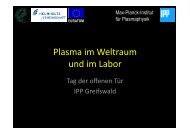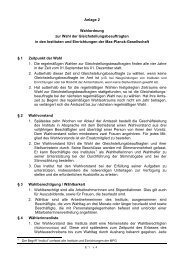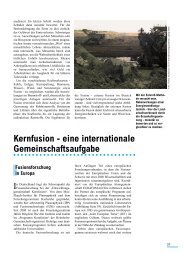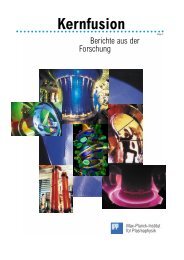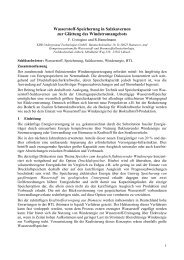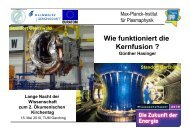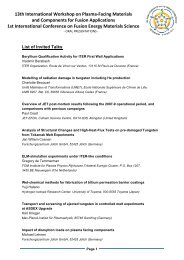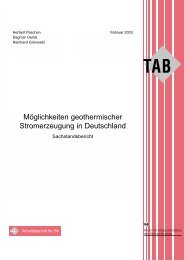IPP Annual Report 2007 - Max-Planck-Institut für Plasmaphysik ...
IPP Annual Report 2007 - Max-Planck-Institut für Plasmaphysik ...
IPP Annual Report 2007 - Max-Planck-Institut für Plasmaphysik ...
Create successful ePaper yourself
Turn your PDF publications into a flip-book with our unique Google optimized e-Paper software.
control but also because of the novel physics arising from the interaction with fast fusionproduced<br />
α-particles. More empirically based, but motivated by an overwhelming practical<br />
need, are the contributions of the <strong>Institut</strong>e to edge and divertor-plasma modelling.<br />
JET was operational for the first three months of the year. The ITER-relevant experiments<br />
to elucidate the effect of the toroidal field ripple were a highlight. A noticeable difference<br />
in confinement, toroidal rotation, ELM frequency and amplitude between JET and JT-60U<br />
in Japan was found in otherwise identical discharges. In the following months JET operation<br />
was interrupted to install the ITER-like ICRH antenna as well as a new pellet injection<br />
system. Parallel to the shutdown, the JET EP2 project has proceeded well and the<br />
2008 campaigns C20-C25 were prepared. The MPI for Plasma Physics has been<br />
involved in many of these activities. In particular, two scientists from the <strong>Institut</strong>e were<br />
appointed to support the management of the JET Task Forces S1 and E.<br />
A major new part of the contribution of the <strong>Institut</strong>e to ITER during <strong>2007</strong> was participation<br />
in the design review. The design review panel was divided into working groups<br />
which were charged with evaluating and prioritising the list of open issues in the ITER<br />
design and with finding appropriate solutions. The MPI for Plasma Physics also contributes<br />
actively to the physics definition of ITER via the International Tokamak Physics<br />
Activity. The expertise of the <strong>Institut</strong>e is in demand for a wide range of activities in<br />
support of ITER, based not only on the results from ASDEX Upgrade but also on knowhow<br />
in the Technology, Theory, Materials and Stellarator Divisions. This work ranges<br />
from studies of plasma scenarios to work on specific heating and diagnostic systems.<br />
Within the project “Plasma-facing Materials and Components” the areas of plasma-wall<br />
interaction studies, material modification under plasma exposure, development of new<br />
plasma-facing materials and their characterisation have been merged to form a field of<br />
competence at the <strong>Institut</strong>e. The work supports the development of fusion devices at the<br />
<strong>Institut</strong>e and also generates basic expertise with regard to plasma-facing components in<br />
ITER and fusion reactors. The activities are strongly embedded in the materials research<br />
community: The MPI for Plasma Physics coordinates the large EU Integrated Project<br />
“ExtreMat” with 37 partners and heads the European Task Force on Plasma-Wall<br />
Interactions.<br />
Following a year of consolidation the Directorate and the Board of Scientific Directors<br />
are confident that the project Wendelstein 7-X is now back on track and that the new<br />
completion date will be kept. Fortunately, the ASDEX Upgrade Team has overcome the<br />
limitations caused by the severely damaged flywheel generator EZ4. The excellent work<br />
of the staff in all Divisions in <strong>2007</strong> has ensured that the <strong>Institut</strong>e will continue to play a<br />
central role in international fusion research.<br />
On behalf of the Directorate and the Board of Scientific Directors I would like to thank<br />
them all for their invaluable contributions.<br />
Scientific Director Alex Bradshaw




